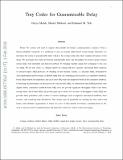Tiny Codes for Guaranteeable Delay
Author(s)
Malak, Derya; Medard, Muriel; Yeh, Edmund M
DownloadAccepted version (937.6Kb)
Terms of use
Metadata
Show full item recordAbstract
© 2019 IEEE. Future 5G systems will need to support ultra-reliable low-latency communications scenarios. From a latency-reliability viewpoint, it is inefficient to rely on average utility-based system design. Therefore, we introduce the notion of guaranteeable delay which is the average delay plus three standard deviations of the mean. We investigate the trade-off between guaranteeable delay and throughput for the point-to-point wireless erasure links with unreliable and delayed feedback, by bringing together signal flow techniques to the area of coding. We use tiny codes, i.e., sliding window by coding with just 2 packets, and design three variations of selective-repeat ARQ protocols, by building on the baseline scheme, i.e., uncoded ARQ, developed by Ausavapattanakun and Nosratinia: (i) Hybrid ARQ with soft combining at the receiver; (ii) cumulative feedback-based ARQ without rate adaptation; and (iii) coded ARQ with rate adaptation based on the cumulative feedback. Contrasting the performance of these protocols with uncoded ARQ, we demonstrate that the HARQ performs only slightly better, the cumulative feedback-based ARQ does not provide significant throughput while it has a better average delay, and the Coded ARQ can provide gains up to about 40% in terms of throughput. The Coded ARQ also provides delay guarantees, and is robust to various challenges such as imperfect and delayed feedback, burst erasures, and round-trip time fluctuations. This feature may be preferable for meeting the strict end-to-end latency and reliability requirements of the future use cases of ultra-reliable low-latency communications in 5G, such as mission-critical communications and industrial control for critical control messaging.
Date issued
2019Department
Massachusetts Institute of Technology. Research Laboratory of ElectronicsJournal
IEEE Journal on Selected Areas in Communications
Publisher
Institute of Electrical and Electronics Engineers (IEEE)